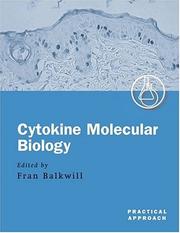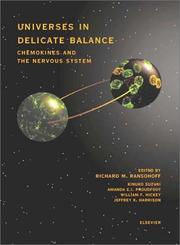| Listing 1 - 10 of 13 | << page >> |
Sort by
|

ISBN: 0121821889 9780121821883 Year: 1997 Volume: 287 Publisher: New York, NY ; London : Academic Press,
Abstract | Keywords | Export | Availability | Bookmark
 Loading...
Loading...Choose an application
- Reference Manager
- EndNote
- RefWorks (Direct export to RefWorks)
Enzymology --- Chemokinen --- Chemokines --- Chimokines --- Inflammatory cytokines --- Chimiokines

ISBN: 0199638578 0199638586 Year: 2000 Publisher: Oxford [etc.] : Oxford University Press,
Abstract | Keywords | Export | Availability | Bookmark
 Loading...
Loading...Choose an application
- Reference Manager
- EndNote
- RefWorks (Direct export to RefWorks)
Cytokines. --- Gene amplification. --- Genetic Techniques. --- Genetic Techniques --- Chemokines --- Cytokines
Book
ISBN: 3038427276 Year: 2018 Publisher: Basel, Switzerland : MDPI,
Abstract | Keywords | Export | Availability | Bookmark
 Loading...
Loading...Choose an application
- Reference Manager
- EndNote
- RefWorks (Direct export to RefWorks)
A hallmark of inflammation is the accumulation of leukocytes, which can serve to remove pathogens and necrotic tissue, but may also damage healthy tissue and exacerbate the inflammatory response. Our understanding of leukocyte recruitment in inflammation was revolutionized in the late 1980s by the discovery of chemokines (chemotactic cytokines), a family of small, secreted proteins that induce migration of selective subsets of leukocytes. Shortly afterwards, chemokines were found to exert their functions through the now familiar chemokine receptors, members of the G protein-coupled receptor superfamily. As their physiological and pathological functions were elucidated, chemokine receptors have become popular targets for drug development in inflammatory diseases as well as cancer metastasis and HIV infection. Extensive research has revealed that the functions of chemokines and their receptors are regulated at numerous levels, including: genetic mutations/polymorphisms; control of expression levels; ligand internalization via functional or decoy receptors; intrinsic selectivity of chemokine-receptor binding; hetero- or homo-oligomerization of chemokines or of receptors; alternative signalling pathways; interaction of chemokines with glycosaminoglycans; post-translational modifications; and binding to pathogen-derived inhibitors. This Special Issue of IJMS focused on the natural and pharmacological mechanisms by which the activities of chemokines and their receptors can be regulated.
Chemokines. --- Chemotactic cytokines --- Inflammatory peptides --- Intercrines --- Cytokines --- Inflammation --- Peptides --- Mediators
Book
ISBN: 0123749077 9786612169519 1282169513 0080956963 9780123749079 Year: 2009 Publisher: Amsterdam ; Boston : Academic Press/Elsevier,
Abstract | Keywords | Export | Availability | Bookmark
 Loading...
Loading...Choose an application
- Reference Manager
- EndNote
- RefWorks (Direct export to RefWorks)
The understanding of chemokines, the proteins that control the migration of cells, and their receptors, is critical to the study of causes and therapies for a wide range of human diseases and infections, including certain types of cancer, inflammatory diseases, HIV, and malaria. This volume, focusing on chemokine structure and function, as well as signaling, and its companion volume (Methods in Enzymology volume 461, focusing on chemokines as potential targets for disease intervention) provide a comprehensive overview and time-tested protocols in this field, making it an essential refer
Chemokines. --- Immune system. --- Immunological system --- Chemotactic cytokines --- Inflammatory peptides --- Intercrines --- Anatomy --- Immunology --- Cytokines --- Inflammation --- Peptides --- Mediators

ISBN: 1281036706 9786611036706 0080518796 0126896631 9780126896633 9781435612761 1435612760 9781281036704 6611036709 9780080518794 Year: 2003 Publisher: Amsterdam ; Boston : Academic Press,
Abstract | Keywords | Export | Availability | Bookmark
 Loading...
Loading...Choose an application
- Reference Manager
- EndNote
- RefWorks (Direct export to RefWorks)
The fourth edition of The Cytokine Handbook provides an encyclopedic coverage of the molecules that induce and regulate immune responses. Now expanded to two volumes, co-edited by Michael T Lotze, and written by over 120 international experts, the scope of the book has been broadened to include a major emphasis on the clinical applications of cytokines. The early chapters discuss individual cytokines, chemokines and receptors. Additional chapters discuss the clinical implications and applications of cytokines, including cytokine gene transfer, antisense therapy and assay systems. Th
Cytokines --- Chemokines --- Chemotactic cytokines --- Inflammatory peptides --- Intercrines --- Inflammation --- Peptides --- Cellular immunity --- Immune response --- Mediators --- Regulation

ISBN: 9780444510020 0444510028 1423755472 9781423755470 0080520197 9780080520193 128102838X 9781281028389 9786611028381 Year: 2002 Publisher: Amsterdam New York Elsevier
Abstract | Keywords | Export | Availability | Bookmark
 Loading...
Loading...Choose an application
- Reference Manager
- EndNote
- RefWorks (Direct export to RefWorks)
It is commonly acknowledged that the nervous system and the immune system, those most complex of networks, share attributes beyond their intricacy. Elements common to the two systems include memory, connectivity, flexibility and developmental selection of cellular composition by a rigorous process involving widespread programmed cell death. There is one salient difference: the cells of the immune system are predominantly in constant motion, while post-mitotic neurons and glia are largely fixed in place. Therefore, chemokines, initially characterized as leukocyte chemoattractants, have for t
Neuropathology --- Neuroimmunology. --- Chemokines. --- Chemotactic cytokines --- Inflammatory peptides --- Intercrines --- Cytokines --- Inflammation --- Peptides --- Neuroimmunomodulation --- Immunology --- Neurosciences --- Mediators
Book
ISBN: 0123749085 9786612169526 1282169521 0080956971 Year: 2009 Publisher: Amsterdam ; Boston : Academic Press/Elsevier,
Abstract | Keywords | Export | Availability | Bookmark
 Loading...
Loading...Choose an application
- Reference Manager
- EndNote
- RefWorks (Direct export to RefWorks)
The understanding of chemokines, the proteins that control the migration of cells, and their receptors, is critical to the study of causes and therapies for a wide range of human diseases and infections, including certain types of cancer, inflammatory diseases, HIV, and malaria. This volume, focusing on chemokines as potential targets for disease intervention, and its companion volume (Methods in Enzymology volume 462, focusing on chemokine structure and function, as well as signaling) provide a comprehensive overview and time-tested protocols in this field, making it an essential refe
Chemokines. --- Microbiology & Immunology --- Animal Biochemistry --- Biology --- Human Anatomy & Physiology --- Health & Biological Sciences --- Immune system. --- Immunological system --- Chemotactic cytokines --- Inflammatory peptides --- Intercrines --- Anatomy --- Immunology --- Cytokines --- Inflammation --- Peptides --- Mediators
Book
ISBN: 3540657592 3642642837 3642601626 Year: 1999 Volume: 246 Publisher: Berlin : Springer,
Abstract | Keywords | Export | Availability | Bookmark
 Loading...
Loading...Choose an application
- Reference Manager
- EndNote
- RefWorks (Direct export to RefWorks)
Workshops on the mechanisms of B cell neoplasia have been organized alternatively in Bethesda and Basel since 1983. Prog ress in our understanding of the development and responses of B lymphocytes is presented and discussed with the aim and hope to understand what might go wrong when B lymphocytes are transformed into malignant cells. Such knowledge might lead to better diagnosis, prevention and even cure of these terri ble diseases. The presentations at the Bethesda workshops are published as papers in volumes of Current Topics in Microbiol ogy and Immunology, while the presentations and discussions in Basel were transcribed and published in Editions Roche. For the first time, a Basel workshop (held 4th-6th October 1998) that has been recorded and, in part, transcribed is being published as papers and discussions within Current Topics. This volume is the latest of a long series which documents the excitements of ground-breaking discoveries as well as the frustrations of our inability to fully understand the mechanisms leading to B cell neoplasia. The papers at the workshop are presented when possible in the sequence in which they were given. However, to facilitate the organization and reading of the book and to highlight gen eral topics and themes, the papers are organized into five sec tions: I B Cell and Plasma Cell Development II Chemokines and Chemokine Receptors III Chromosomal Translocations, DNA Rearrangements and Somatic Hypermutations IV Biology of Lymphomagenesis, B-CLL, Autoimmunity V Myeloma, Plasmacytomas and Related Subjects.
B-Lymphocytes --- Cell Transformation, Neoplastic --- Chemokines --- congresses --- Congresses --- congresses. --- Congresses. --- B cells --- Tumors --- Cancer cells --- Cell transformation --- Immunology. --- Cancer research. --- Internal medicine. --- Cancer Research. --- Internal Medicine. --- Medicine, Internal --- Medicine --- Cancer research --- Immunobiology --- Life sciences --- Serology --- B lymphocytes --- Bone marrow derived cells --- Bursa equivalent cells --- Antigen presenting cells --- Lymphocytes
Dissertation
ISBN: 8789468023 Year: 1991
Abstract | Keywords | Export | Availability | Bookmark
 Loading...
Loading...Choose an application
- Reference Manager
- EndNote
- RefWorks (Direct export to RefWorks)
Cat Diseases. --- Interleukin-8. --- 636.7 --- Feline Diseases --- Cat Disease --- Disease, Cat --- Disease, Feline --- Diseases, Cat --- Diseases, Feline --- Feline Disease --- Dogs --- Theses --- Cat diseases --- INTERLEUKIN-8 --- 636.7 Dogs --- Cat diseases. --- INTERLEUKIN-8. --- AMCF-I --- Alveolar Macrophage Chemotactic Factor-I --- Anionic Neutrophil-Activating Peptide --- Chemokines, CXCL8 --- Chemotactic Factor, Neutrophil --- Granulocyte Chemotactic Peptide-Interleukin-8 --- IL8 --- Monocyte-Derived Neutrophil Chemotactic Factor --- Neutrophil Activation Factor --- CXCL8 Chemokine --- Chemokine CXCL8 --- Chemotactic Factor, Macrophage-Derived --- Chemotactic Factor, Neutrophil, Monocyte-Derived --- IL-8 --- Neutrophil-Activating Peptide, Lymphocyte-Derived --- Neutrophil-Activating Peptide, Monocyte-Derived --- Alveolar Macrophage Chemotactic Factor I --- Anionic Neutrophil Activating Peptide --- CXCL8 Chemokines --- CXCL8, Chemokine --- Chemokine, CXCL8 --- Chemotactic Factor, Macrophage Derived --- Chemotactic Peptide-Interleukin-8, Granulocyte --- Granulocyte Chemotactic Peptide Interleukin 8 --- Interleukin 8 --- Lymphocyte-Derived Neutrophil-Activating Peptide --- Macrophage-Derived Chemotactic Factor --- Monocyte-Derived Neutrophil-Activating Peptide --- Neutrophil Activating Peptide, Lymphocyte Derived --- Neutrophil Activating Peptide, Monocyte Derived --- Neutrophil Chemotactic Factor --- Neutrophil-Activating Peptide, Anionic --- Peptide, Anionic Neutrophil-Activating --- Cat Diseases --- Interleukin-8
Book
ISBN: 3036546006 3036545999 Year: 2022 Publisher: MDPI - Multidisciplinary Digital Publishing Institute
Abstract | Keywords | Export | Availability | Bookmark
 Loading...
Loading...Choose an application
- Reference Manager
- EndNote
- RefWorks (Direct export to RefWorks)
Nanoparticles (NPs) offer unique properties for biomedical applications, leading to new nanomedicines. Recent examples of advanced nanoparticle-based nanomedicines are COVID-19 RNA vaccines. Regardless of the delivery route of the NPs into the body (intravenous or subcutaneous injection, oral, intranasal, etc.), NPs inevitably come into contact with immune cells, such as macrophages. Macrophages are phagocytizing cells that determine the fate and the lifetime of NPs in relevant biological fluids or tissues, which has consequences for both nanosafety and nanomedicine. The aim of this Special Issue is to cover recent advancements in our understanding of NP–macrophage interactions, with a focus on in vitro models for nanosafety and novel nanomedicine approaches that allow the modulation of the immunological profile of macrophages. The current Special Issue compiles nine papers: seven research articles and two review articles. The original articles include studies on the interaction of different nanomaterials, such as multi-walled carbon nanotubes (MWCNTs), amorphous silica, gold nanoparticles, lipid carriers, and microspheres, with macrophages in different scenarios.
Medicine --- chronic wound --- device --- foot ulcer --- inflammation --- wound healing --- macrophage --- nanomaterial --- nanoparticle --- drug delivery --- immune system --- anti-inflammatory --- innate immunity --- osteoarthritis --- rifabutin --- nanostructured lipid carriers --- cell uptake --- Caco-2 cells --- oral administration --- Crohn’s disease --- nanomaterials --- macrophages --- class A type 1 scavenger receptors --- cytotoxicity --- macrophage–nanoparticle interaction --- monocytes --- gold nanoparticles --- in vitro models --- innate memory --- 2D cultures --- 3D cultures --- carbon nanotube --- scavenger receptor --- phagocytosis --- protein corona --- bovine serum albumin --- synthetic amorphous silica --- in vitro testing --- NR8383 alveolar macrophage --- ICP-MS analysis of cell bound SiO2 --- multi-walled carbon nanotubes --- nanoparticles --- chemokines --- transcriptomics --- zebrafish --- n/a --- Crohn's disease --- macrophage-nanoparticle interaction
| Listing 1 - 10 of 13 | << page >> |
Sort by
|

 Search
Search Feedback
Feedback About
About Help
Help News
News